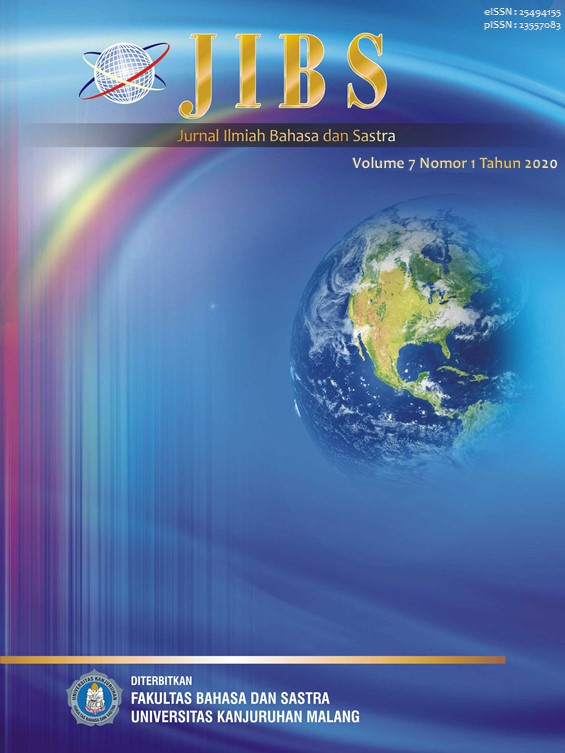DEVELOPING ELT MATERIALS: THE KEY TO FOSTERING EFFECTIVE INSTRUCTION OF READING COMPARISON AND CONTRAST TEXTS
DOI:
https://doi.org/10.21067/jibs.v7i1.4509Keywords:
ELT Materials, Reading Comprehension, Comparison and Contrast Texts, expository texts, ELT programAbstract
Reading comparison and contrast texts in English language teaching (ELT) program was developed which ensured a range of students could be facilitated with instructional materials for their course and level of study. These materials have been developed around the concept of educational inclusion, intercultural communication and information and communication technology (ICT) utilization which can be combined into whole units of learning (topics), teaching and learning activities and media, and ultimately a student book, student work book, and lecturer guide. On the basis of the underlying philosophy from the new curriculum of the study program, we considered effective instruction to be a key element in engaging students with reading materials. There were six stages of R&D method from Borg and Gall (2003) modified by the researchers consist of need analysis, developing material, expert validation, revision, try out, and the final product. Three instruments consist of informal interview, expert’s validation checklist, and questionnaire for the product try out were utilized to develop reading comprehension instructional materials. The products consisted of student book chapter, student workbook chapter, and lecturer manual book chapter of reading comparison, and contrast texts. In consequence, the key aim of this development was to stimulate and engage students, fostering better involvement with the reading comprehension materials and hence better learning.
References
Aini, W. M. (2015). New developments in teaching reading comprehension skills of efl learners. European Centre for Research Training and Development UK. Vol.3, No. 1, pp. 1-10.
Alqahtani, M. A. (2015). The Effects of Think-Aloud Strategy to Improve Reading Comprehension of 6th Grade Students In Saudi Arabia. Journal of Applied Linguistics and Language Research, 5, 52-59.
Ancheta, R. F. (2018). Reading Ability of Efl Learners: The Case Of Level 3 Students of Gulf College, Oman. European Journal of English Language Teaching, 3, 20-33.
Asmawati, A. (2015). The Effectiveness Of Skimming – Scanning Strategy In Improving Students’ Reading Comprehension At The Second Grade Of Smk Darussalam Makassar. 1, 69-83.
Badger, R. (2018). Teaching and Learning the English Language: A Problem-Solving Approach. Great Britain.
Bhaatt, D. & Lilian. (2016). An Analysis of Receptive and Productive Skills of English Language With Special Reference to Indigenous People In Odisha. International journal of English language, literature and translation studies (IJELR), 3, 633-639.
Broderick. (1990). Groundwork for College Reading. Townsend Press.
Borg, W. R., & Gall. M., D. 1983. Educational Research an Introduction. New York and London: Longman Inc.
Dick, W, & Carey. L. 2001. The Systematic Design of Instructional. London’ Macmillan.
Emaliana, I., Lintangsari, A. P, & Perdhani, W.C. (2019). Do Epistemic Beliefs Predict Meaningful Reading Comprehension? Findings from A Correlational Study of EFL Students. The 3rd International Language and Tourism Conference, Malaysia, 235-241
Grellet, F. (1981). Developing Reading Skills. Cambridge, New York: Cambridge University Press.
Harmer, J. (2007). How to Teach Language New edition. United Kingdom: Pearson Education limited.
Harmer, J. (1998). How To Teach English. England: Addison Wesley Longman.
Klassen, R. T. (2014). Comparison & contrast writing. Douglas Collage Press.
Lauder, A. (2018). The Status and Function of English In Indonesia: A Review of Key Factors. Akara, Sosial Humaniora, 12, 9-20.
Major, J. H. (2016). Guidelines for Designing Effective English Language Teaching Materials. 101-109.
Nan, C. (2018). Implications of Interrelationship among Four Language Skills for High School English Teaching. Journal of Language Teaching and Research, 9, 418-423.
Ngure, G, et al. (2014). Utilization of Instructional Media For Quality Training in Pre-Primary School Teacher Training Colleges in Nairobi Country, Kenya. Reseachjournali’s Journal of Education. Vol. 2. No. 7. ISSN 2347-8225.
Nira Erdiana, U. K. (2017). QAR Strategy Implementation for Reading Comprehension of Recount Text. Studies in English Language and Education, 247-256.
Nuttall, C. (1996). Teaching Reading Skills in a Foreign Language. Oxford: The Bath Press.
Puspitasari, I., Emaliana, I., Lailiyah, N, Lintangsari, A. P., Soewarso, P.N. (2019). Interweaving EFL Learners’ Speaking, Reading, Writing Strategies and Epistemic Beliefs to Language Achievement through E-Learning. International Conference on Advances in Education, Humanities, and Language Proceeding.
Rahmiati, I.I. & Emaliana, I. (2019). EFL Students' Online Learning: Epistemic Beliefs Determine Learning Strategies. Journal on Education of English as Foreign Language, Volume 2 No. 2.
Sabouri, A. P. (2016). A Study of Factors Affecting EFL Learners’ Reading Comprehension. International Journal of English Linguistics, 6, 180-187.
Sarjan, N. (2017). An Analysis on The English Teachers Strategies in Teaching Reading Comprehension SMP 1 of Wonomulyo. 151-160.
Smith, S. (2019). Compare & Contrast Essays. Retrieved September 21, 2019, from EAP Foundation Web Site: https://www.eapfoundation.com
Tomlinson, B. (2013). Developing Materials for Language Teaching. Chennai, India: Newgen Knowledge Works Press.
Zein, M. S. (2017). Elementary English education in. Elementary English Education In Indonesia, 53-57.
Downloads
Published
How to Cite
Issue
Section
License
JIBS (Jurnal Ilmiah Bahasa dan Sastra) allows readers to read, download, copy, distribute, print, search, or link to the full texts of its articles and allow readers to use them for any other lawful purpose. The journal allows the author(s) to hold the copyright without restrictions. Finally, the journal allows the author(s) to retain publishing rights without restrictions

This work is licensed under a Creative Commons Attribution-ShareAlike 2.0 Generic License.

